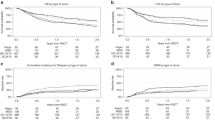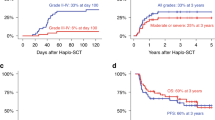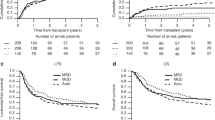Abstract
We conducted a retrospective registry-based analysis to compare the outcome of 361 allogeneic human leukocyte antigen (HLA)-identical peripheral blood stem cell transplants (PBSCT) with reduced intensity conditioning (RIC) to that of 1369 autologous (auto) PBSCT in patients aged 50 years or older with de novo acute myeloid leukemia (AML), performed from 1997 until 2003 and reported to the European Group for Blood and Marrow Transplantation. Median age was 58 and 57 years in the RIC and auto groups, respectively. RIC patients had more advanced disease at the time of transplant. At a median follow-up of 24 months for RIC and 16 months for auto, multivariate analysis showed a lower risk for relapse (RR 0.77, P=0.013) without increased non-relapse mortality (NRM) in RIC patients (RR 1.26, P=0.28). Moreover, leukemia-free survival (RR 1.22, P=0.02) and overall survival (OS) (RR 1.32, P=0.005) were superior in the RIC group. In patients in 1st (CR), fewer relapses were counterbalanced by significantly increased NRM. Therefore, there was no survival advantage in this subgroup. In patients in 2nd or subsequent CR, LFS and OS were superior in the RIC group. RIC transplants show encouraging results in this older patient population with de novo AML.
This is a preview of subscription content, access via your institution
Access options
Subscribe to this journal
Receive 12 print issues and online access
$259.00 per year
only $21.58 per issue
Buy this article
- Purchase on Springer Link
- Instant access to full article PDF
Prices may be subject to local taxes which are calculated during checkout



Similar content being viewed by others
References
Stone RM, O'Donnell MR, Sekeres MA . Acute myeloid leukemia. ASH Education Program Book 2004, 98–117.
Estey EH . How I treat older patients with AML. Blood 2000; 96: 1670–1673.
Ferrara F . Unanswered questions in acute myeloid leukaemia. Lancet Oncol 2004; 5: 443–450.
Juliusson G, Billström R, Gruber A, Hellström-Lindberg E, Höglund M, Karlsson K et al. Attitude towards remission induction for elderly patients with acute myeloid leukaemia influences survival. Leukaemia 2006; 20: 42–47.
Gorin NC . Autologous stem cell transplantation in acute myeloid leukemia. Blood 1998; 92: 1073–1090.
Breems DA, Löwenberg B . Autologous stem cell transplantation in the treatment of adults with acute myeloid leukaemia. Br J Haematol 2005; 130: 825–833.
Zittoun RA, Mandelli F, Willemze R, de Witte T, Labar B, Resegotti L et al. Autologous or allogeneic bone marrow transplantation compared with intensive chemotherapy in acute myelogenous leukemia. N Engl J Med 1995; 332: 217–223.
Cassileth PA, Harrington DP, Appelbaum FR, Lazarus HM, Rowe JM, Paietta E et al. Chemotherapy compared with autologous or allogeneic bone marrow transplantation in the management of acute myeloid leukemia in first remission. N Engl J Med 1998; 339: 1649–1656.
Reiffers J, Stoppa AM, Attal M, Michallet M, Marit G, Blaise D et al. Allogeneic vs autologous stem cell transplantation vs chemotherapy in patients with acute myeloid leukemia in first remission: The BGMT 87 study. Leukemia 1996; 10: 1874–1882.
Suciu S, Mandelli F, de Witte T, Zottoun R, Gallo E, Labar B et al. Allogeneic compared to autologous stem cell transplantation in the treatment of patients younger than 46 years with acute myeloid leukemia (AML) in first complete remission (CR1): an intention-to-treat analysis of the EORTC/GIMEMA AML-10 trial. Blood 2003; 102: 1232–1240.
Ringden O, Horowitz MM, Gale RP, Biggs JC, Gajewski J, Rimm AA et al. Outcome after allogeneic bone marrow transplant for leukemia in older adults. JAMA 1993; 270: 57–60.
Niederwieser D, Gentilini C, Hegenbart U, Lange T, Becker C, Wang SY et al. Allogeneic hematopoietic cell transplantation (HCT) following reduced intensity conditioning in patients with acute leukemias. Crit Rev Oncol Hematol 2005; 56: 275–281.
Slavin S, Nagler A, Naparstek Y, Kapelushnik Y, Aker M, Cividalli G et al. Nonmyeloablative stem cell transplantation and cell therapy as an alternative to conventional bone marrow transplantation with lethal cytoreduction for the treatment of malignant and nonmalignant hematologic diseases. Blood 1998; 91: 756–763.
Giralt S, Estey E, Albitar M, van Besien K, Rondon G, Anderlini P et al. Engraftment of allogeneic hematopoietic progenitor cells with purine analog-containing chemotherapy: harnessing graft-versus-leukemia without myeloablative therapy. Blood 1997; 89: 4531–4536.
Mohty M, de Lavallade H, Ladaique P, Faucher C, Vey N, Coso D et al. The role of reduced intensity conditioning allogeneic stem cell transplanatation in patients with acute myeloid leukemia: a donor versus no donor comparison. Leukemia 2005; 19: 916–920.
McSweeney PA, Niederwieser D, Shizuru JA, Sandmaier BM, Molina AJ, Maloney DG et al. Hematopoietic cell transplantation in older patients with hematologic malignancies: replacing high-dose cytotoxic therapy with graft-versus-tumor effects. Blood 2001; 97: 3390–3400.
Bertz H, Potthoff K, Finke J . Allogeneic stem-cell transplantation from related and unrelated donors in older patients with myeloid leukemia. J Clin Oncol 2003; 21: 1484–1840.
Wong R, Giralt SA, Martin T, Couriel DR, Anagnostopoulos A, Hosing C et al. Reduced intensity conditioning for unrelated donor hematopoietic stem cell transplantation as treatment for myeloid malignancies in patients older than 55 years. Blood 2003; 102: 3052–3059.
Sayer HG, Kröger M, Beyer J, Kiehl M, Klein SA, Schaefer-Eckart K et al. Reduced intensity conditioning for allogeneic hematopoietic stem cell transplantation in patients with acute myeloid leukemia: disease status by marrow blasts is the strongest prognostic factor. Bone Marrow Transplant 2003; 31: 1089–1095.
Hegenbart U, Niederwieser D, Sandmaier BM, Maris MB, Shiruzu JA, Greinix H et al. Treatment for acute myelogenous leukemia by low-dose total-body, irradiation-based conditioning and hematopoietic cell transplantation from related and unrelated donors. J Clin Oncol 2006; 24: 444–453.
Shimoni A, Hardan I, Shem-Tov N, Yeshurun M, Yerushalmi R, Avigdor A et al. Allogeneic hematopoietic stem-cell transplantation in AML and MDS using myeloablative versus reduced intensity conditioning: the role of dose intensity. Leukemia 2006; 20: 322–328.
Shimoni A, Kröger N, Yabelina T, Ayuk F, ardan I, Yeshurun M et al. Hematopoietic stem cell transplantation from unrelated donors in elderly patients (age >55 years) with hematologic malignancies: older age is no longer a contraindication when using reduced intensity conditioning. Leukaemia 2005; 19: 7–12.
Alyea EP, Kim HT, Ho V, Cutler C, Gribben J, DeAngelo DJ et al. Comparative outcome of nonmyeloablative and myeloablative allogeneic hematopoietic cell transplantation for patients older than 50 years of age. Blood 2005; 105: 1810–1814.
Aoudjhane M, Labopin M, Gorin NC, Shimoni A, Ruutu T, Kolb HJ et al. Comparative outcome of reduced intensity and myeloablative conditioning regimen in HLA identical sibling allogeneic haematopoietic stem cell transplantation for patients older than 50 years of age with acute myeloblastic leukaemia: a retrospective survey from the Acute Leukemia Working Party (ALWP) of the European group for Blood and Marrow Transplantation (EBMT). Leukemia 2005; 19: 2304–2312.
Przepiorka D, Weisdorf D, Martin P, Klingemann HG, Beatty P, Hows J et al. 1994 Consensus conference on acute GVHD grading. Bone Marrow Transplant 1995; 15: 825–828.
Shulman HM, Sullivan KM, Weiden PL, McDonald GB, Striker GE, Sale GE et al. Chronic graft-versus-host syndrome in man: a long-term clinicopathologic study of 20 Seattle patients. Am J Med 1980; 69: 204–217.
Gooley TA, Leisenring W, Crowley J, Storer BE . Estimation of failure probabilities in the presence of competing risks: new representations of old estimators. Stat Med 1999; 18: 665–706.
Cox DR . Regression models and life tables. J Roy Stat Soc. 1972; 34: 187–202.
Fine JP, Gray RJ . A proportional hazards model for the subdistribution of a competing risk. Journal of American Statistical Association 1999; 94: 496–509.
Tauro S, Craddock C, Peggs K, Begum G, Mahendra P, Cook G et al. Allogeneic stem-cell transplantation using a reduced intensity conditioning regimen has the capacity to produce durable remissions and long-term disease-free survival in patients with high-risk acute myeloid leukemia and myelodysplasia. J Clin Oncol 2005; 23: 9387–9393.
Author information
Authors and Affiliations
Consortia
Corresponding author
Appendix
Appendix
List of participating centres with three or more RIC patients included:
Institut Paoli Calmettes, Marseille, France, D Blaise; CHU Bordeaux Hôpital Haut-Lévèque, Pessac, France, N Milpied; University of Leipzig, Leipzig, Germany, D Niederwieser; Hôpital A Michallon, Grenoble, France, JY Cahn; University Hospital Brno, Brno, Czech republic, J Mayer; Medizinische Klinik und Poliklinik, Ulm, Germany, D Bunjes; Sahlgrenska University Hospital, Goeteborg, Sweden, M Brune; University Hospital, Basel, Switzerland, A Gratwohl; University Hospital, Zürich, Switzerland, U Schanz; Medizinische Universitaet Wien, Vienna, Austria, H Greinix; Manchester Royal Infirmary, Manchester, UK, J Liu Yin; University Hospital Eppendorf, Hamburg, Germany, AR Zander; GKT School of Medicine King's Denmark Hill Campus, London, UK, GJ Mufti; Cliniques Universitaires St-Luc, Brussels, Belgium, A Ferrant; Hôpital Henri Mondor, Créteil, France, C Cordonnier; Hadassah University Hospital, Jerusalem, Israel, S Slavin; University Hospital Innsbruck, Innsbruck, Austria, G Gastl; Ospedale V Cervello, Palermo, Italy, R Scimè; University Hospital, Linköping, Sweden, N Theorin; Chaim Sheba Medical Centre, Tel-Hashomer, A Nagler; Plymouth Hospitals NHS Trust Derriford Hospital, Plymouth, UK, MD Hamon; University Medical centre, Utrecht, The Netherlands, LF Verdonck; Erasmus MC-Daniel den Hoed Cancer Centre, Rotterdam, The Netherlands, JJ Cornelissen; Hotel Dieu, Nantes, France, JL Harousseau; Hospital Santa Creu I Sant Pau, Barcelona, Spain, J Sierra; Ospedale di Careegi, Firenze, Italy, A Bossi; Heinrich Heine Universität, Düsseldorf, Germany, G Kobbe; Hopital de Purpan, Toulouse, France, M Attal; Hôpital E Herriot, Lyon, France, M Michallet; Hopital Hautepierre, Strasbourg, France, B Lioure; Hospital Clínico, Salamanca, Spain, D Caballero; St. Bartholomew's and The Royal London Hospital West Smithfield, London, UK, J Gribben; Universitaetsklinikum Dresden, Dresden, Germany, G Ehninger; University of Freiburg, Freiburg, Germany, J Finke; HSS Antonio e Biagio, Alessandria, Italy, B Allione; Hotel Dieu, Paris, France, B Rio; Azienda Ospedaliera S Giovanni, Torino, Italy, M Falda; Hopital Jean Minjoz, Besançon, France, E Deconinck; St. James Hospital Trinity College, Dublin, Ireland, S McCann; Ospedale Niguarda Ca'Granda, Milano, Italy, S Siena; Policlinico San Matteo, Pavia, Italy, EP Alessandrino; Hannover Medical university, Hannover, Germany, B Hertenstein; Goethe-Universität Medizinische Klinik II, Frankfurt, Germany, D Hoelzer; University of Wales, Cardiff, UK, K Wilson; Policlinico Le Scotte, Siena, Italy, F Lauria; University Hospital Maastricht, Maastricht, The Netherlands, H Schouten; Institute of Hematology and Blood Transfusion, Prague, Czech Republic, A Vitek; Institut Gustave Roussy, Villejuif, France, JH Bourhis; University of Münster, Münster, Germany, J Kienast; Charles University Hospital, Pilsen, Czech Republic, V Koza; K Marcinkowski University of Medical Science, Pozna, Poland, M Komarnicki; Umea University Hospital, Umea, Sweden, A Wahlin; University of Saarland, Homburg, Germany, J Schubert; Charité Universitätsmedizin Berlin, Berlin, Germany, R Arnold.
List of participating centres with seven or more auto patients included:
Institut Paoli Calmettes, Marseille, France, D Blaise; Royal Marsden Hospital, London, UK, M Potter; Kliniken Essen Süd, Essen, Germany, W Heit; Cardarelli Hospital, Napoli, Italy, F Ferrara; Hôpital E Herriot, Lyon, France, M Michallet; University La Sapienza, Rome, Italy, R Foa; CHU Bordeaux Hôpital Haut-Lévèque, Pessac, France, N Milpied; Robert-Bosch-Krankenhaus, Stuttgart, Germany, S Martin; Hospital Clinic, Institute of Hematology and Oncology, Barcelona, Spain, E Carreras; Hotel Dieu, Paris, France, B Rio; Spedali Civili-Brescia, Brescia, Italy, G Rossi; Hannover Medical university, Hannover, Germany, B Hertenstein; Heinrich Heine Universität, Klinik für Hämat, Düsseldorf, Germany, G Kobbe; Hospital Universitario La Fe, Valencia, Spain, MA Sanz; Johannes-Gutenberg University, Mainz, Germany, K Kolbe; Universitaetsklinikum Dresden, Dresden, Germany, G Ehninger; Rambam Medical Center, Haifa, Israel, JM Rowe; Centre Hospitalier Universitaire Vaudois, Lausanne, Switzerland, A Rosselet; Hospital U Marqués de Valdecilla, Santander, Spain, A Iriondo Atienza; VU university Medical centre, Amsterdam, The Netherlands, GJ Ossenkoppele; Charles University Hospital, Hradec Králové, Czech Republic, L Jebavy; Hotel Dieu, Nantes, France, JL Harousseau; Medical University Graz, Graz, Austria, W Linkesch; Leiden University Hospital, Leiden, The Netherlands, R Willemze; Medizinische Klinik und Poliklinik, Ulm, Germany, D Bunjes; Karolinska University Hospital, Stockholm, Sweden, O Ringden; Christie NHS Trust Hospital, Manchester, UK, E Liakopoulou; Hospital Santa Creu I Sant Pau, Barcelona, Spain, J Sierra; University Tor Vergata, St Eugenio Hospital, Rome, Italy, W Arcese; University medical Centre St Radboud, Nijmejen, A Scattenberg; Erasmus MC-Daniel den Hoed Cancer Centre, Rotterdam, The Netherlands, JJ Cornelissen; Hopital de Purpan, Toulouse, France, M Attal; Azienda Ospedali Riuniti di Ancona, Ancona (Torrette), Italy, A Olivieri; Cliniques Universitaires St. Luc, Brussels, Belgium, A Ferrant; Hospital Reina Sofia, Córdoba, Spain, A Torres-Gomez; Kantonsspital Aarau, Aarau, Switzerland, M Bargetzi; Hospedale Nord Taranto Italy, P Mazza; ULB - Hopital Erasme, Brussels, Belgium, W Feremans; Klinikum Nürnberg, Nürnberg, Germany, H Wandt; S Bortolo Hospital Vicenza, Italy, F Rodeghiero; University Hospital Gasthuisberg, Leuven, Belgium, J Maertens; University Hospital Bern, Bern, Switzerland, K Leibundgut; University Hospital Center Rebro, Zagreb, Croatia, B Labar; AZ Stuivenberg, Antwerp, Belgium, P Zachée; Medisch Spectrum Twente, Enschede, The Netherlands, MR Schaafsma; Hospital Universitari Germans Trias i Pujol, Barcelona, Spain, JM Ribera Santasusana; Royal Perth Hospital, Perth, Australia, RP Herrmann; Hopital Saint Antoine, Paris, France, NC Gorin; Ospedale di Niguarda Ca Granda, Milano, Italy, E Morra; Hospital San Maurizio, Bolzano, Italy, P Coser; University Hospital, Olomouc, Czech Republic, K Indrák; Charité - Campus Benjamin Franklin, Berlin, Germany, L Uharek; Ege University Medical School, Bornova-Izmir, Turkey, S Cagirgan; Charles University Hospital, Pilsen, Czech Republic, V Koza.
Rights and permissions
About this article
Cite this article
Herr, AL., Labopin, M., Blaise, D. et al. HLA-identical sibling allogeneic peripheral blood stem cell transplantation with reduced intensity conditioning compared to autologous peripheral blood stem cell transplantation for elderly patients with de novo acute myeloid leukemia. Leukemia 21, 129–135 (2007). https://doi.org/10.1038/sj.leu.2404461
Received:
Revised:
Accepted:
Published:
Issue Date:
DOI: https://doi.org/10.1038/sj.leu.2404461
Keywords
This article is cited by
-
Long-term results of reduced-intensity conditioning allogeneic hematopoietic cell transplantation for older patients with acute myeloid leukemia: a retrospective analysis of 10-year follow-up data
Bone Marrow Transplantation (2020)
-
Allogeneic hematopoietic stem cells transplantation improves the survival of intermediate-risk acute myeloid leukemia patients aged less than 60 years
Annals of Hematology (2019)
-
Allogeneic Hematopoietic Stem Cell Transplantation for Older Patients With Acute Myeloid Leukemia
Current Treatment Options in Oncology (2018)
-
Reduced intensity conditioning of allogeneic hematopoietic stem cell transplantation for myelodysplastic syndrome and acute myeloid leukemia in patients older than 50 years of age: a systematic review and meta-analysis
Journal of Cancer Research and Clinical Oncology (2017)
-
Comparable outcomes between autologous and allogeneic transplant for adult acute myeloid leukemia in first CR
Bone Marrow Transplantation (2016)



